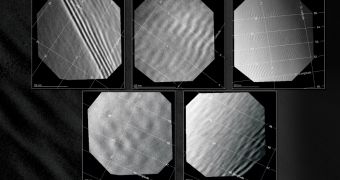Officials at the European Space Agency have recently released new data collected by their Venus Express spacecraft currently orbiting Earth's neighboring planet. For this investigation, the probe focused its instruments on the high-level clouds blanketing the planet's atmosphere.
Some of the most interesting things the vehicle observed were many small-scale wave trains of clouds developing in Venus' northern hemisphere. ESA experts also determined that these structures tended to develop over a region called Ishtar Terra, which includes the world's highest mountains.
This region is very large, and could be likened to a continent here on Earth. Venus Express was able to determine that its mountains are sufficiently high to create distortions in the massive layers of clouds swirling overhead. Interestingly, winds on this planet can reach speeds of 300 to 400 kilometers (186.5 to 248.6 miles) per hour.
Another interesting aspect of the cloud cover is that it forms in a layer of the Venusian atmosphere that is 203.15 Kelvin, or minus 70 degrees Celsius (-94ºF). By comparison, the planet's surface suffers from a runaway greenhouse effect, exhibiting temperatures of up to 723.15 Kelvin (450°C or 842°F).
Closer to the surface, wind speeds do not exceed 3 to 5 kilometers (1.9 to 2.5 miles) per hour. The altitudes where these two classes of winds blow are separated by 60 to 70 kilometers (37 to 43 miles) of atmosphere, ESA researchers say.
As studies of Venus progressed, experts determined that the entire atmosphere resembled an ocean, with the high-speed winds at the top acting as ocean currents on Earth to reveal slower motions taking place close to the world's surface. In the new study, Venus Express demonstrated that atmospheric waves propagate from the surface to the outer reaches of the atmosphere.
This motion is largely prompted by the tall mountains of Ishta Terra, the researchers determined. “We don't yet fully understand how such topographic forcing can extend to high levels, but it seems likely to be one of the key processes for the generation of gravity waves at high northern latitudes on Venus,” says researcher Silvia Tellmann.
“The waves may form when a stable air flow passes over the mountain,” adds the expert, who holds an appointment with the Rhine Institute for Environmental Research at the University of Cologne, in Germany. She and her team authored a study on these landscape features at the end of 2012.
The new investigation that finally confirmed their findings was published in the January 2014 issue of the journal Icarus, and led by Arianna Piccialli, who conducted the work while based at the ESA European Space Research and Technology Center (ESTEC), in the Netherlands.
“This is an exciting result because it strengthens the case that topography is likely to be a significant influence on the atmospheric circulation of Venus. This influence has been predicted by models but never observed in such detail until now,” says researcher Håkan Svedhem.
“Understanding the mechanisms of surface influence on atmospheric processes is crucial for understanding the maintenance of the remarkably rapid circulation of the atmosphere at Venus' cloud tops,” adds the expert, who is an ESA project scientist for Venus Express.

 14 DAY TRIAL //
14 DAY TRIAL //